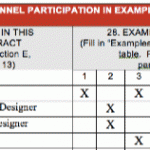 It`s always up for debate. You want to create a proposal cover that will pique the client’s interest. You may think you spend enough time on proposal covers. But others may think you don’t spend ENOUGH time on them. Well, who’s right?
It`s always up for debate. You want to create a proposal cover that will pique the client’s interest. You may think you spend enough time on proposal covers. But others may think you don’t spend ENOUGH time on them. Well, who’s right?
Or maybe someone else on your team does the covers. How much time should you give them to complete this task? When should you tell them, “That’s enough.”
I’m going to give you a formula that will calculate exactly how much time you should spend on your proposal cover. It can get a little complicated, but it’s important that you spend enough time on your proposal cover without stealing away precious time and attention from the message of your proposal.
This formula is time-tested and will work in every instance, except for one situation (which we’ll get into later).
Now, I understand you might need time to develop or gather graphics for a proposal theme (like Laura Ricci did with her Calvin and Hobbes theme). But the time spent putting together the cover should adhere strictly to the results of each calculation.
Here’s the Proposal Cover Formula.
Step One
First, estimate the number of pages that will be in your proposal. You don’t have to be exact, but be sure to include forms, resumes, etc. Write that number down.
Step Two
Next, identify the very next number. For example, if you estimated four pages, the next number is five. Write that number down as well.
Step Three
Now add those two numbers together. Write the answer down.
Step Four
Add nine to that number. Write that answer down.
Step Five
Take the number from step four and divide it by two. Write the answer down.
Step Six
Subtract your original estimate (I.e, the number from step one) from the number you came up with in step five.
This final answer is the number of minutes you should spend coming up with your proposal cover.
The Formula in Practice
OK, let’s say you have a 63-page proposal. The next number would be 64. So you add those together.
64+63=127
Now, we add nine.
127+9=136
Next, we divide 136 by 2.
136/2=68
Finally, we subtract our original page estimate (63).
68-63=5
There is your answer. You should spend five minutes putting together the cover for this proposal.
Obviously, it helps if you have a template for your proposal covers. But be careful, spending less than five minutes could lead to a sloppy first impression. Spend any more than five minutes and you’ll be stupidly wasting precious time you could be using to focus on the things that will actually influence the proposal evaluator’s decision.
The One Exception
There is one instance when this formula will not work. It’s important that you remember this exception. If you find yourself in this situation and use the proposal cover formula, you may actually hurt your chances with the client.
The only instance where you can’t use the proposal cover formula is when you are developing a proposal to design proposal covers for a client (ironic, huh?). In all other situations, this formula will work.
In fact, I’m so convinced of this that if you can prove to me that you used my formula and lost a proposal competition because of lack of time spent on the cover…I’ll give you and your entire team free copies of Proposal Development Secrets!
This offer does not apply to the one exception I mentioned.
So, next time you’re arguing about how much time to spend on a proposal cover…just use the Proposal Cover Formula and be done with all the nonsense.
If you liked this article, please subscribe below or on the right side of the homepage. If you want to give us your thoughts on this issue, please leave a comment below.





MY formula says: 6. I’ve assigned 3 of my best proposal team staff to comb through our equations right now to understand how we can be over by 20%!?!?
Nils,
Thank you for the comment. I admire your dedication to precision. 🙂
It would be great to understand your rationale for selecting that specific formula. Why? I don’t understand why a link between page count and time spent on the cover is important?
Mary,
Thank you for the comment.
It’s a bit of a math trick. If you run the formula a couple times, you’ll get it.
Ok, the old trick! I think the designers in our company would have a hard time believing that number!
Matt, What is not included in your formula is the client. If the client is a straight nuts or bolts firm, then yes — your formula will work. For example, if I submitted a fancy cover to a small Texas municipality — we’d get kicked-out because they would interpret the fancy cover as “expensive rates.” However, I recently prepared an AEC proposal, of a similar length to your example, to a very sophisticated client. To show we undertood what theya re trying to create with the project, we had a graphic artist come up with a special design. Again — it boils down to knowing your client!
Jeannette,
Thank you for your comment. If I had a client who had proposals covers pinned to his/her office wall, I think I would spend a lot of time on the cover because that person is cRaZy.
In the example you give, I would ask the client, “How much did the cover of the proposal weigh on your decision?”
Another thing, if you are outsourcing to someone who is not in your office, then it doesn’t matter how much time they spend. It’s now a question of money. What’s important is how much time you spend on the cover at the expense of another part of the proposal.
Thanks you made me laugh. I needed this. I LOVE the proposal covers we do. And I also like this math trick regardless of its validity. This is a great way to focus on what is important. Thanks for sharing. I am going to share it with my team.
Oh Matt… And to think we were getting along so nicely:) I would agree that spending needless time agonizing over and editing a cover when the project approach isn’t written is not a productive use of time. However, marketing teams are employed to ‘make stuff pretty’. Covers may not win work outright, but they are the first impression of the proposal.
One thing used at my previous employer that I’ve carried with me is breaking proposal development into a tiered structure. Contract value determines which tier level is used and each tier has templates/themes for covers/tabs/org charts/page layouts/etc. This allows the marketing coordinator to present options to the PM while maintaining a firms design and branding standards. And usually only takes 5-10 minutes to input the appropriate client/proposal information.
The only exception was if the contract is high value (determined by someone at the top) and then a graphic designer could create a customized proposal look. Which, I’m proud to say, did play a role in winning a couple of contracts for proposals I submitted at said previous firm.
This system worked because it allowed everyone to do their job in a more efficient manner. Graphic designers could spend more time on billable work; marketing coordinators could spend more time helping technical folks create great content; and PMs could spend more time tailoring project approaches to the specific client’s needs.
Of course there were plenty of PMs who still worried about the cover but I just lump them in the crazy category.
Jennifer,
No No No. Anyone who hires a marketer for the express purpose of making stuff “look pretty” is insane. Hire a graphic designer for that (or outsource one). Marketers influence decisions. Those who are not doing that are not in marketing.
Your tiered structure makes a lot of sense.
And a “customized proposal look” and a proposal cover are two different things. Was it the cover or the overall look of the proposal which played a role in winning the proposal?
As soon as I wrote the ‘look pretty’ comment I knew I should have explained more. I think technical staff have a hard time understanding the difference between marketing and graphics; many think if you can do one certainly you can do the other. So the general comment is ‘just make it pretty’. They know we make a difference but the only tangible item they can point to is a cover design.
The tier structure was great because the templates were set up for anyone to use. But the designs were created by a highly talented graphic designer.
The feedback we received from the client was the cover made them want to read our proposal but the overall look/theme put us over the top of our also highly qualified competition. I should also mention I truly believe that is the one and only time in my career the look of the proposal will make a difference. The look/feel happened by accident during a brainstorming session with the graphic designer. He took it and created an unbelievable design. And we were fortunate enough to work with technical staff who wanted me to do my job of influencing decisions.
Jennifer,
Thank you for the comment. I do think themes are a good thing, especially if you have insight into the client’s needs/challenges.
Amen.
This is indeed an interesting approach. I love numbers (even though I’m a writer) so if nothing else, it’s worth a shot! I would like to take it one step further..
New opportunities present themselves often; and, more often than not, my team is asked to take on a pursuit (pre-qual,SOQ,etc.) that “doesn’t require a lot of writing” or “should only take 20 hours to complete.” I think anyone who has been involved in a proposal process knows better than to underestimate the resources and time required. So, the million dollar question is: do you have a magic formula that can help us gain a realistic estimate of the time it will take to complete a document from start to finish?
Lindsey,
Thank you for the comment. The formula for the time to complete a document (start to finish) is the same as for the time to complete a construction project (start to finish).
:p